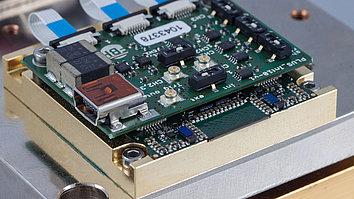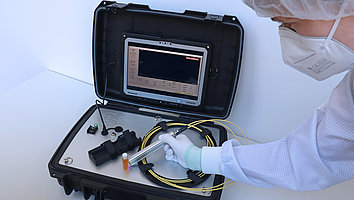FBH to showcase advanced diode lasers and UV LEDs at Laser World of Photonics – from chips to prototypes
The Ferdinand-Braun-Institut, Leibniz-Institut für Höchstfrequenztechnik (FBH) will present its full range of capabilities at Laser World of Photonics in Munich from April 26-29, 2022 – from design and chips to modules and systems. At the Berlin-Brandenburg joint booth B5.528, the institute will be exhibiting, among other things, an irradiation system with optimized 233 nm far-UVC LEDs. Such systems are used in medical applications to inactivate multi-resistant pathogens and corona viruses directly on the skin.
Also on display is a transportable, spectrometerless system for Raman measurements performed on a selected substance. Demonstrator systems with integrated spectrometer have already been successfully used several times for on-site measurements: on fruit, on agricultural soils and in the medical environment. The previous measurement principle, based on a spectrally adjustable diode laser system that can be quickly switched between two wavelengths, has now been simplified. Thanks to an integrated filter, it can be used without a spectrometer. This makes the measuring system more cost-effective and even more compact.
FBH also presents its progress in pulsed pump lasers (pulse width 5...10 ms) with high repetition rate (10...100 Hz) for future solid-state laser systems of the high energy class, which are now also suited for pumping thulium-doped crystals. For example, an improved chip design with a wavelength around 780 nm increased the efficiency by about 10 % and the output power per stack to 1.6 kW.
Selected further developments presented at the booth:
LiDAR pulse laser source for line scanners with 2 kW output power
FBH's high-power pulsed laser source is based on a diode laser bar with 48 emitters and is ideally suited for 3D object detection as required for line scanners in the field of automotive LiDAR. Scanning LiDAR systems emit fast laser pulses that are reflected by objects. For this purpose, line scanners use a laser array that measures scanning points over a wide line. The returning laser pulses are captured by a detector array. Using 1D laser beam steering, line scanners therefore cover a large area. The advanced laser source delivers 2 kW pulse power for 8 ns pulses at 1.15 kA pulse current. It is based on wavelength-stabilized multi-diode lasers emitting at 905 nm with multiple tunnel diodes and active layers in a common waveguide. Due to the on-chip DBR, the emission wavelength changes with temperature by only 0.06 nm/K, and the spectral width of the laser emission is only 0.25 nm.
RGB laser modules for holographic laser printers in medicine
FBH is developing semiconductor laser modules that will be integrated into an innovative and cost-effective laser system for holographic laser printers. The lasers emit in the red, green and blue spectral range (RGB). For the green and blue sources, the light is generated by frequency doubling from the near-infrared (NIR) range at 914 nm and 1064 nm using nonlinear crystals. Thanks to the unique properties of the broadly applicable RGB laser modules, 3D holograms can be efficiently created. The light sources are currently being integrated into a hologram printer for medical use. With them, a specific plastic is printed, which is then illuminated, creating an animated full-color hologram with complete object information that can be used for diagnostics as well as surgery planning. FBH will demonstrate the high coherence of its laser sources with a live demonstrator, a yellow-emitting diode laser module that can be used for ophthalmology as well as for laser projections.


